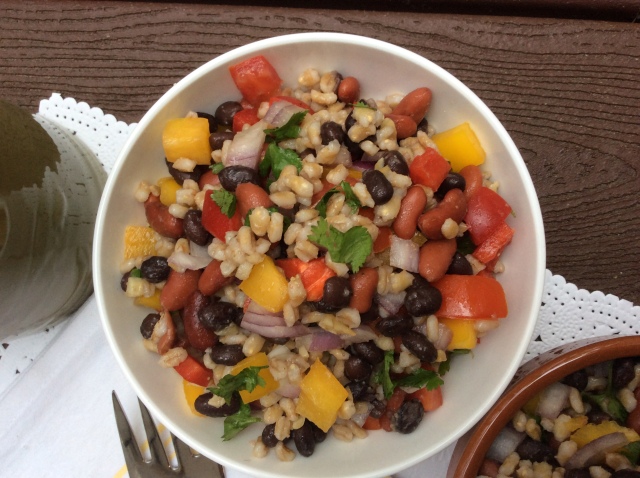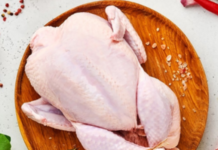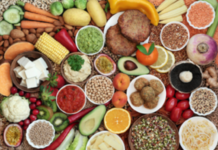 By Sangeeta Pradhan
By Sangeeta Pradhan
INDIA New England Nutrition Columnist
Getting a little tired of quinoa, but want a reasonable, whole grain substitute? Look no further than farro, an ancient variety of wheat called emmer, that has a delightful crunch!
Whether it takes center stage in a soup, or tossed into a salad, stir fried with crunchy veggies, or consumed as hot cereal with your favorite dried fruit and nuts, you will love how versatile this grain is.
What’s more-packed with approximately 7 whopping grams of fiber per serving*, rich in iron, magnesium and phenolic antioxidants, farro holds the promise of upstaging other popular whole grains. Is this whole grain poised to become the next quinoa?** Time will tell, so stay tuned for updates on this rising star!!!
The use of finely chopped garlic, cumin and freshly squeezed lime juice adds a flavorful punch to this wholesome salad. In fact, I may refer to it as a salad, but this is actually a complete meal with protein from the beans, whole grains from farro, unsaturated fats from the olive oil and veggies from the red onions and peppers to boot!
* Fiber and nutrient content might vary from brand to brand. 1/4 cup uncooked, dry farro has roughly 7 grams of fiber and 37 grams of carbohydrate. It should be noted that since farro is a form of wheat, it is not gluten-free.
**Although quinoa is used as a whole grain in many recipes, it is actually a seed.
Number of servings: 11, 1/2 cup servings
Ingredients:
- 1/2 cup raw farro
- 3/4 cup canned, red kidney beans, rinsed and drained
- 3/4 cup canned, black beans, rinsed and drained
- 2 tbsp. fresh, finely chopped garlic
- 3/4 cup red onion, diced
- 1/2 cup each, diced yellow and red peppers
- 1 tsp cumin powder
- 2 tbsp olive oil
- 1/2 tsp salt, or to taste
- 2 tbsp freshly chopped cilantro, + 1 tbsp for garnish
- 3/4 -1 tbsp. of freshly squeezed lime juice
Method:
- Cook the farro per cooking directions, adding a pinch of salt to the cooking water and set aside.
- Add 2 tbsp olive oil in a thick bottomed saucepan.
- Add the freshly chopped garlic, and saute until fragrant and a very light golden brown.
- Add cumin to the garlic and toss in the rinsed beans, stirring until coated with the finely chopped garlic and cumin powder.
- Stir in the cooked farro and 2 tbsp of cilantro into the bean-garlic mixture in the pan. Transfer the entire mixture to a large serving bowl,
- Mix the lime juice and salt.
- Add the chopped red onion and peppers to the farro in the bowl.
- Drizzle the salted lime juice, tossing gently to coat.
- Garnish with the tbsp of reserved cilantro. May be served warm or cold.
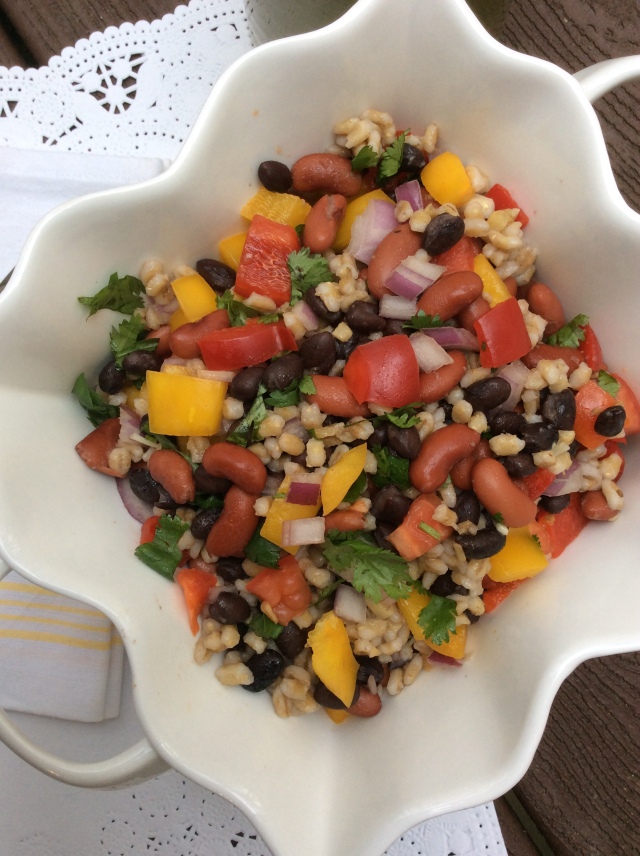
© Copyright, 2015-2017, Sangeeta Pradhan, RD, LDN, CDE.
A Registered Dietitian’s tip:
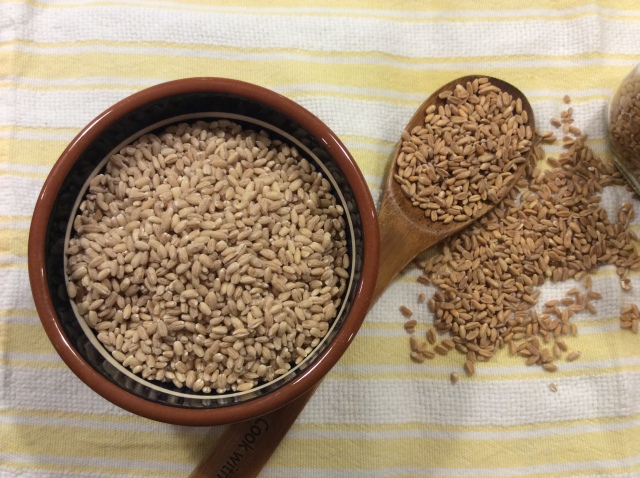
Farro or emmer (Triticum dicoccum), is a form of wheat that is packed in fiber, iron, and magnesium. © Copyright, 2015-2017, Sangeeta Pradhan, RD, LDN, CDE.
So what’s so promising about farro??
- Positive effect on gut bacteria: In a 6 week randomized trial where whole grains were substituted for refined grains, a favorable positive effect was seen on gut bacteria, short chain fatty acids and the acute inflammatory response. In case that sounds like scientific mumbo-jumbo, there is scientific evidence demonstrating the role of our gut bacteria in shaping the course of chronic diseases such as diabetes, obesity and digestive disorders. Certain forms of fiber called prebiotics serve as fuel for the growth of friendly bacteria in our gut. These bacteria, subsequently ferment the fiber to produce short chain fatty acids, which are organic acids that can keep out the bad bugs by inhibiting their growth. Thus, high fiber diets have been linked with the proliferation of protective bugs, while the consumption of a typical Western diet high in refined grains, low in fiber, and high in animal proteins and saturated fats can cause an unfavorable alteration in the ratio of good to bad bugs, and subsequent inflammation. The study noted above, showed a modest, positive effect on gut bacteria as well as the acute inflammatory response.
- Proof in the whole grain: Epidemiological and clinical studies demonstrate that intake of dietary fiber and whole grain is inversely related to obesity, type 2 diabetes, possibly cancer and cardiovascular disease.
- Filling the fiber gap: Did you know that the average American consumes only 11-19 grams of fiber per day, a number that is woefully short of the recommended 25-38 grams per day? However, at 7 grams of fiber per serving, farro packs a considerable fiber punch. Thus, a mere couple of servings would go a long way in filling the fiber gap that America faces. So go ahead, dig in and enjoy!
Disclaimer: This blog is strictly for informational purposes only, and should not be construed as medical advice. Please consult your physician or registered dietitian for recommendations tailored to your specific needs.




